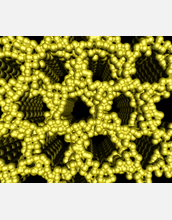Multimedia Gallery
Nanostructured Platinum
Nanostructured Platinum
This illustration shows nanostructured platinum with pores arranged in an ordered, honeycomb-like pattern. The metal pattern is about one million times smaller than the typical honeycomb pattern found in a beehive, and the pores are just large enough to allow the efficient transport of small molecules through the pores. The nanostructured platinum results from a synthesis method developed by Cornell University researchers in which appropriately designed platinum nanoparticles automatically assemble into complex, ordered patterns. These porous metal structures have the capability to transform the development of more efficient and cheaper catalysts for fuels cells and industrial processes and materials for microchip fabrication.
The research was headed by Uli Wiesner, Cornell professor of materials science and engineering, who received a grant from the National Science Foundation's (NSF) Division of Materials Research. For more information about this research, see the NSF news release, "New method 'self-assembles' metal atoms into porous nanostructures." [Research supported by NSF grants DMR 06-05856 (single investigator award), DMR 05-20404 (Materials Research Science and Engineering Center) and DMR 02-25180 (Cornell High Energy Synchrotron Source)]. (Date of Image: June 2008)
Credit: Image courtesy Scott Warren and Uli Wiesner, Cornell University
Images and other media in the National Science Foundation Multimedia Gallery are available for use in print and electronic material by NSF employees, members of the media, university staff, teachers and the general public. All media in the gallery are intended for personal, educational and nonprofit/non-commercial use only.
Images credited to the National Science Foundation, a federal agency, are in the public domain. The images were created by employees of the United States Government as part of their official duties or prepared by contractors as "works for hire" for NSF. You may freely use NSF-credited images and, at your discretion, credit NSF with a "Courtesy: National Science Foundation" notation.
Additional information about general usage can be found in Conditions.
Also Available:
Download the high-resolution JPG version of the image. (1.8 MB)
Use your mouse to right-click (Mac users may need to Ctrl-click) the link above and choose the option that will save the file or target to your computer.



